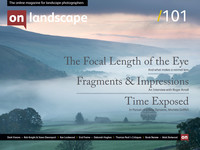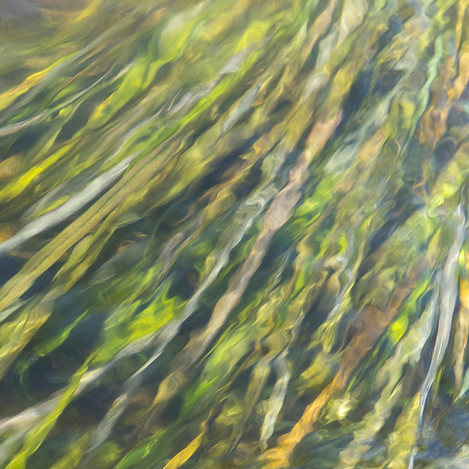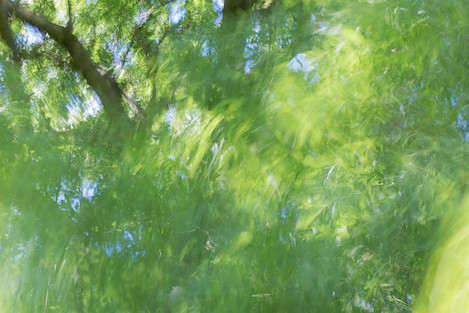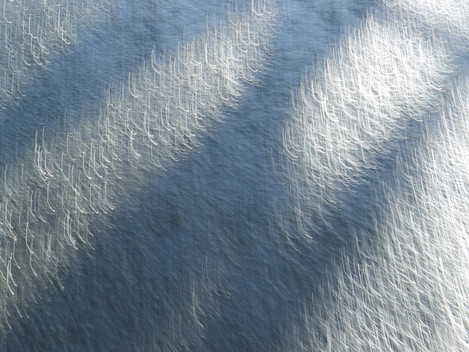In Pursuit of a New Dynamic

Michéla Griffith
In 2012 I paused by my local river and everything changed. I’ve moved away from what many expect photographs to be: my images deconstruct the literal and reimagine the subjective, reflecting the curiosity that water has inspired in my practice. Water has been my conduit: it has sharpened my vision, given me permission to experiment and continues to introduce me to new ways of seeing.
In our search for perfection, however defined, we seek to be in the right place, at the right time, and to trip the shutter at the right moment. We strive to craft an image just so – to show the landscape at its best, in the right light. A fragment or a view. A sublime moment or a perfect juxtaposition frozen for eternity. For much of the time our emphasis is on aperture, depth of field, focus.
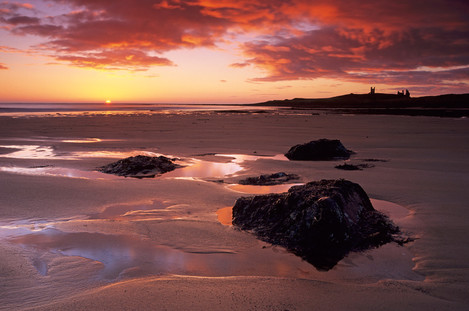
Embleton Bay - Inevitably we are influenced in our tastes by what we see in print and online, and light gets all the glory
For many years I was content to tread a common path but when I started making images of water and light in 2012, it quickly became addictive. You can read about my journey in two previous articles for On Landscape: Going with the Flow and Take Me to the River.
Including movement reinvigorated my photography, but also changed the way that I look at the land. The appeal of the conventional diminished – for all the care taken, and whatever the merit of the light, both vistas and details seemed, somehow, lacking. It took me a while to work out why – perhaps because I started looking for an ‘on land’ equivalent before I fully understood why I sought the change. As a landscape photographer I had learnt to exclude movement, to shoot aperture priority, to use a tripod and to slow down. A moving subject meant changing first to shutter priority, and then to manual, allowing me to control both time (I wish!!) and depth of field. Digital with its variable ISO gave me a freedom that I could not have enjoyed had I stayed with film. Taking the camera off the tripod also gave me a more dynamic way of working.
Over the past year I’ve started to experiment and to apply some of the techniques I use to photograph water on the land. By doing so, I’ve learnt why a method of making images that I had previously been happy with for many years had paled for me. David Ward wrote in ‘Landscape Within’ that “Light’s equal partner in photography is time”, yet light gets the glory and the headlines.
How do we define time? The moment that we release the shutter? The minutes spent composing the image? The hours spent travelling to our destination? The days of research and planning? The years of practice? For me it is the fraction of a second or a minute, or the multiple thereof, that the shutter remains open and the potential that this offers.
Our experience of the land is proportionate to time – the anticipation that precedes each holiday or trip, the time that it takes to reach a place, or to move through it. “Are we there yet?” Move too fast and our sense of space is diminished. The more we slow our progress through an area - and our photography down - the more we experience, the more we see. Sometimes our images may fall short because we cannot always separate our own experience of making the image from that which the viewer will see and know. We seek to show beauty in a moment, the edge of the day, the turn of the season, the majesty of nature in – however much we include foreground detail or lead in lines - a two dimensional image. The transformation that light can make is so beguiling that we may be excused a degree of complacency, yet however carefully we craft these views, they simply document the landscape.
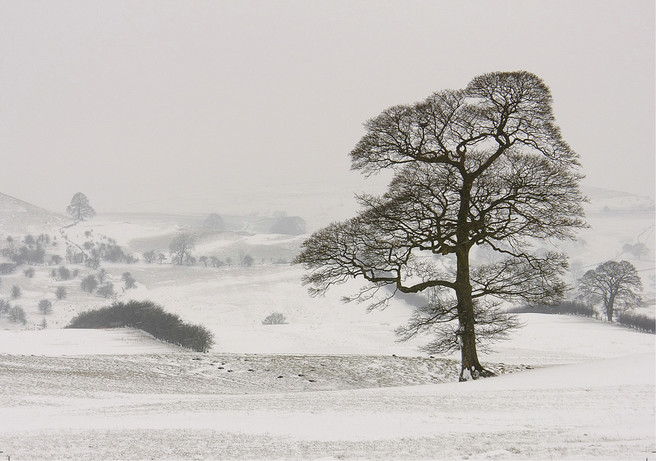
Blizzard (Fields and Trees). The appeal for me of this image is undoubtedly linked to the experience of making it in driving snow yet I have to recognise that its quiet softness may not translate.
The earth, as we experience it through nature and the land, and the physical, ecological and social forces that shape it, is dynamic. Its perpetual motion – earth around the sun, moon around the earth - is reflected in our tides and weather systems. Extremes result in flooding or drought. Water and wind erode. Organisms – plant and animal – are born, live, decline and decay. We interfere with nature and ‘manage’ the land, shaping it to our own needs. Where we leave be, nature does its best to recover. Forces within may manifest themselves as earthquakes and eruptions with attendant emissions of vapour, gas, ash and lava. Turn our eyes to the sky and we perceive our own movement as that of the sun. At night, the moon and stars. Solar activity rebounds as the northern (or southern) lights.
As landscape photographers we tend to go to extremes – short shutter speeds to freeze the moment, or long exposures of several minutes, sometimes falsely exaggerated using ND filters. Both can reveal things that we would not otherwise perceive – a new reality.
The new land that interests me is the area in between. The dynamic landscape and even my experience of moving through it. Perhaps this restlessness reflects my own.
The effects can be difficult to predict and certainly can’t be controlled. With water it is perhaps a little easier – it moves but the features it passes through, over or around remain mostly stationary, providing an anchor of sorts around which a composition can be formed. Transfer to subjects with a greater freedom of movement, or more random and less predictable forces such as the wind, and it can be less clear where there is potential and what may make a successful image. Photography becomes more experimental, more raw – and perhaps as a result more attuned with nature.
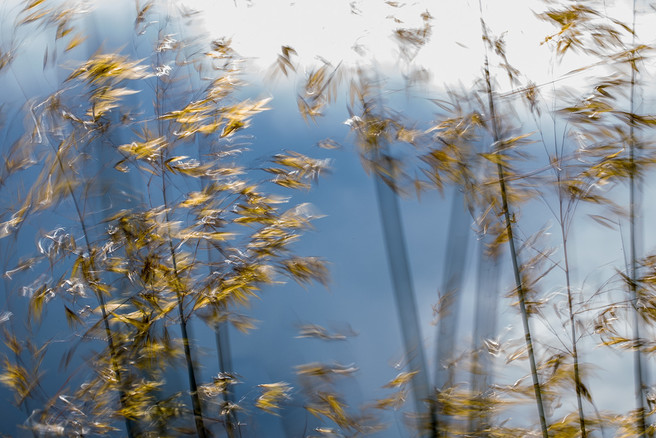
Afternoon sun burnishes the flowers of Stipa gigantea against a darkening sky. In the breeze the stems dance back and forth, back and forth, as if impatient for rain.
At this point you are quite entitled to point out that the images that I (and others) create using slower shutter speeds are still static representations, but for me they retain a legacy of the energy I observed through the lens in the record of movement and the streaks of light.
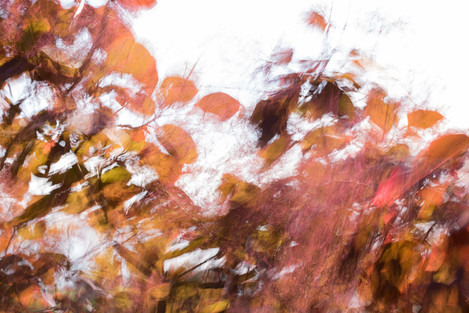
Embers: When I can’t escape out, sometimes I grab a half hour in the garden, though it can easily become longer…. you’ll know the how and why of this. A favourite muse is my Cotinus ‘Flame’.
For now I’m enjoying exploring the possibilities. I don’t tend to think of these as ‘projects’ - they have evolved naturally rather than being the result of conscious decisions. They are simply lines of enquiry, arterial branches. The product of a curious mind and a restless soul – I’m not good at sitting still. I’ve even started to see what is possible during the minutes spent walking the lanes, tripping the shutter as I go.
I’ve learnt that while you may initially follow your camera as equipment, technique and precedent dictate the terms of your relationship with the land, if you continue travelling you can take the lead. You won’t develop this relationship by copying others, but by letting curiosity get the upper hand and by challenging yourself to go beyond both what you see and what you know.
I’m increasingly looking for an impression, a mood – something glimpsed through eyes half closed. I prefer blur to sharp. I prefer movement to static – preferably of subject (which I have taken to calling ‘Intentional Subject Movement’). And while I still prefer to get as much as possible right in camera, I’m not averse to experimenting and increasingly Lightroom is part of the process. I don’t yet know where this will lead, but I’m enjoying the journey and in a strange way the less my images ‘look’ like photographs the happier I am. Now that is something that 3 years ago as a diehard film user and Photoshop purist I could not have predicted.
Michéla’s next solo exhibition is called “Liquid Light” and although its main focus is water, it includes a number of her newly fluid pictures from the land.
The exhibition, at Buxton Museum and Art Gallery, starts with a preview on Saturday 12 September 2015 between 2-4pm. There are two Meet the Artist days, on Saturdays 10 and 31 October, also from 2-4pm. For more see here. The exhibition continues until Saturday 14 November 2015.
- Siren Song – There’s a tune playing if we choose to hear it
- Embleton Bay – Inevitably we are influenced in our tastes by what we see in print and online, and light gets all the glory
- Blizzard (Fields and Trees). The appeal for me of this image is undoubtedly linked to the experience of making it in driving snow yet I have to recognise that its quiet softness may not translate.
- High summer and for once I’m sitting still underneath an ash tree
- Afternoon sun burnishes the flowers of Stipa gigantea against a darkening sky. In the breeze the stems dance back and forth, back and forth, as if impatient for rain.
- Sketches on the Lane – can time spent getting to your location be creative too?
- Embers: When I can’t escape out, sometimes I grab a half hour in the garden, though it can easily become longer…. you’ll know the how and why of this. A favourite muse is my Cotinus ‘Flame’.

